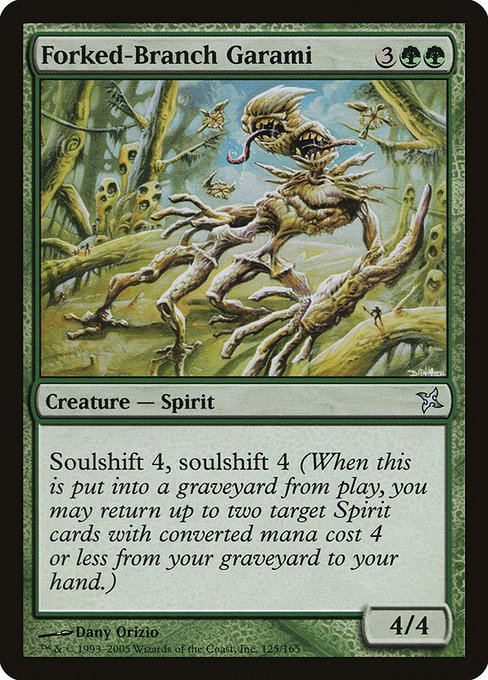
Image courtesy of Scryfall.com
Collecting in a Bubble: Why Forked-Branch Garami Captures the Imagination
Market bubbles in Magic: The Gathering aren’t just about numbers climbing on price charts; they are a vivid reflection of collector psychology at play. Fans chase the thrill of discovery, the whisper of nostalgia, and the idea that a single card can anchor a memory of pulling a first Kamigawa pack or drafting a mind-bending Spirit deck at a kitchen table years ago. Forked-Branch Garami, a green Spirit from Betrayers of Kamigawa, embodies that dual pulse: it’s a creature that feels both timeless in its forested silhouette and timely in its gameplay potential. With a mana cost of {3}{G}{G}, this 4/4 behemoth lands in the sweet spot for midrange pressure, and its Soulshift ability anchors a mini recursion engine that resonates with players who love long games and long memories 🧙♂️🔥.
In the raw mechanics, Soulshift is the heart of Garami’s appeal. Soulshift 4, soulshift 4 means that when Forked-Branch Garami dies, you may return up to two target Spirit cards with mana value 4 or less from your graveyard to your hand. That phrase “two targets, MV 4 or less” is basically a permission slip for chaining value in a graveyard-centric world. It invites a strategic mindset: you don’t simply lose a 4/4 body; you plant seeds for a comeback, converting loss into future gain. It’s a memory of older formats, a wink to players who relish Spirit tribal synergies, and a reminder that in MTG, the graveyard is not a tomb but a workshop 🧙♂️🎲.
“Sometimes the most valuable cards aren’t the loudest in combat, but the quiet engines that loop themselves back into your hand.”
For collectors, the narrative around Garami isn’t just about sticks and numbers; it’s about the promise of recursion and the beauty of Kamigawa’s Spirit motif. Betrayers of Kamigawa is a set that still sparks conversations about design risk and cultural flavor—green creatures that court the ethereal with forest-glade aesthetics, and a Soulshift mechanic that rewards patient play. Garami sits in the uncommon slot, a rarity that tends to see steady, if modest, appreciation among nostalgic participants and color-hungry green players who love evergreen tribes. The art by Dany Orizio contributes as well—its aura of ghostly green and wind-swept trees evokes the set’s storytelling spirit and gives collectors a reason to swing toward a complete or near-complete foil or nonfoil collection. And yes, the foil versions tend to fetch a touch more—though Garami’s price remains a gentle curve rather than a rollercoaster, which suits the bubble that values both memory and strategy 🔥💎.
From a market perspective, Garami’s position offers a microcosm of bubble dynamics. The card’s Price tag—roughly around $0.16 for nonfoil and about $0.46 for foil in the current data snapshot—illustrates a market that’s not chasing unicorns, but interest is still real. Collectors who understand the long-game value of Spirit recursion may be willing to pay a modest premium for a copy in excellent condition or a foil that carries extra display appeal. Yet the data also hints at the fragility of bubbles: a reprint risk, shifts in casual play, or a drift in the broader evergreen power of Spirit decks can nudge demand in unexpected directions. It’s a reminder that real collectors diversify, balancing nostalgia with playability and opportunity cost 🧠🎨.
Practical collectors often frame their decisions around three lenses: condition and presentation, playability in casual or EDH formats, and long-term narrative value. Garami’s Soulshift aligns with a broader trend where older spirits and recursion engines carry an enduring charm, even when the metagame doesn’t revolve around them today. You don’t need a Fearless Commander or a top-tier modern staple to appreciate the card’s design beauty; you simply need to imagine the back-and-forth of graveyard shuffles and last-ditch salvations that make a match feel epic. And if you’re the sort who keeps a little desk-adjacent deckbuilder in your head, Garami becomes more than a card—it becomes a case study in how memory, scarcity, and playability intersect in a market that’s always a little bit bubble, a little bit treasure hunt 🧙♂️⚔️.
On the collecting-cultural side, a green Spirit like Forked-Branch Garami also reminds us how MTG’s mana color identities and creature types can carry lore-forward value. Kamigawa’s lore—with its Shinto-infused spirit world, life in the forests, and the interwoven fates of kami and mortals—gives a thematic depth to a card that otherwise might feel fine but forgettable. The artwork, the frame with its Kamigawa-era typography, and the card’s arc—dying, returning spirits, optional recursions—help create a story that fans want to tell again and again. It’s not just about a single game; it’s about a memory that can be recaptured every time a player draws a fresh hand and the graveyard breathes back into life 🌿🎲.
As you navigate the market’s waves, keep Garami in mind not as a gateway to instant riches but as a durable thread in the tapestry of MTG collecting. It represents a moment when set design, nostalgia, and strategic depth intersect—an intersection that often fuels the most enduring facets of MTG fandom 🧙♂️💎.
If you’re exploring gear to accompany your hobby, consider pairing your collection with a practical accessory—the following store link offers a slim, protective option for your everyday carry. A clean, reliable case doesn't change the game, but it does keep your treasures safe while you shuffle and trade with passion.
Clear silicone phone case slim flexible with open ports
More from our network
- https://transparent-paper.shop/blog/post/ai-generated-paper-patterns-redefine-diy-crafting/
- https://crypto-acolytes.xyz/blog/post/minecraft-creeper-survival-guide-stay-safe-and-smart/
- https://blog.digital-vault.xyz/blog/post/dolliv-nicknames-fans-favorite-monikers-revealed/
- https://crypto-acolytes.xyz/blog/post/ancient-stars-via-low-metallicity-clues-and-a-hot-giant/
- https://blog.digital-vault.xyz/blog/post/distant-blue-white-giant-illuminates-sagittarius-arm/